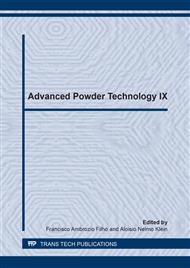p.130
p.135
p.140
p.146
p.152
p.158
p.163
p.168
p.174
Boron-Doped Ultra/Nanocrystalline Diamond Films Obtained with Different Growth Times and Boron Doping Levels
Abstract:
In this work, the achievement and characterization of boron-doped nanocrystalline diamond films is presented. A series of experiments varying boron doping levels from 2,000 to 30,000 ppm and film growth times during 6, 10 and 16 h were performed. These films were analyzed by Scanning Electron Microscoy (SEM), Atomic Force Microscopy (AFM), Raman spectroscopy and Cyclic Voltammetry (CV) measurements. The results showed that the films presented two morphologies: ultra and nanocrystalline diamond. From Raman spectroscopy, the doping level increase for all the films, independent of growth time, increased the boron acceptor number and it was confirmed by Mott-Schottky plot (MSP). Electrochemical response showed the influence of boron content in the work potential window, mainly for films grown during 6 h. However, the reversibility was almost independent on the boron content for samples grown during 16 h.
Info:
Periodical:
Pages:
152-157
Citation:
Online since:
December 2014
Authors:
Keywords:
Price:
Сopyright:
© 2014 Trans Tech Publications Ltd. All Rights Reserved
Share:
Citation:


